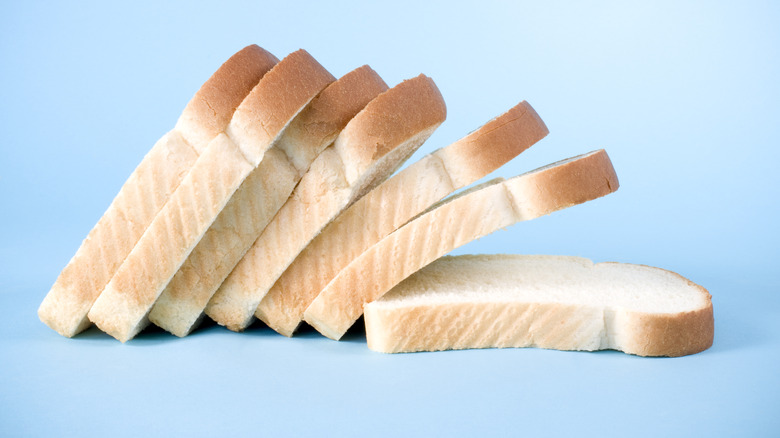The US Once Actually Banned Sliced Bread
Many great inventors have graced the face of this earth. Thomas Edison, Nikola Tesla, and Alexander Graham Bell are just a sampling of the famous names you may have heard in school. However, none of these men, and in fact, no other inventor in history, can hold a candle to Otto Frederick Rohwedder.
Surely you must have heard of him. No? Well, Rohwedder invented something that, by nearly every account, is the greatest thing in history: sliced bread. Perhaps that's overselling things a bit, as Rohwedder certainly wasn't the first person to take a knife to a loaf of bread. But he transformed the baking industry in 1928 with a bread-slicing machine that allowed hungry homeowners to buy pre-cut loaves (per The Atlantic).
By saving consumers a few precious moments (not to mention Band-Aids), Rohwedder cemented his place in history. However, you have to wonder how sliced bread became the benchmark by which all innovations are judged. After all, it seems like an awfully basic concept — hardly something you'd compare to groundbreaking innovations such as the internet or penicillin. But we live in a time when we can take sliced bread for granted, and that wasn't always the case. If you need proof of what an important invention sliced bread was, you need only look back to the time that the United States government banned it and caused a societal meltdown of epic proportions.
Why the US banned sliced bread
The United States banned the sale of sliced bread on January 18, 1943, as part of nationwide rationing during World War II. Per Atlas Obscura, the ban was intended to save two things: the wax paper used for preserving sliced bread and the steel used in slicing machines. However, it was met with harsh backlash.
Publications ran tales of housewives brought to their wits' end by the need to hand-slice bread for the whole family. A mother of four named Sue Forrester wrote a letter to The New York Times, saying, "I should like to let you know how important sliced bread is to the morale and saneness of a household." Time described a scene of "grief, cussing, lopsided slices which even the toaster refused, often a mad dash to the corner bakery for rolls."
Meanwhile, the ban was failing to save as promised, so on March 8, 1943, it was rescinded. According to Mental Floss, the ban was so unpopular that no one in the government wanted to take responsibility for it. The Office of Price Administration blamed the Department of Agriculture, who in turn pointed the finger at the baking industry itself. The official decree had been issued by Food Administrator Claude R. Wickard, though it's unclear whose idea it originally was. All the American people seemed to care about was the ease with which they could again make toast, and the Allies won the war, even without the extra wax paper.
How sliced bread became the 'greatest thing'
Strange as it may seem, sliced bread took a while to catch on. According to the Massachusetts Institute of Technology's Lemelson-MIT program, Iowa-born Otto Frederick Rohwedder first started working on a bread-slicing machine in 1912. But when he pitched his prototype to bakers, they dismissed him, believing pre-sliced bread would go stale too quickly.
Rohwedder addressed this concern by adding a feature to his bread slicer that wrapped the sliced loaves in wax paper. The first baker to take a chance on the invention was Frank Bench of Chillicothe, Missouri, who debuted his pre-sliced loaves on July 7, 1928. Two years later, Wonder Bread adopted the technology, bringing it to national attention.
Still, nobody seems certain of just when and where the phrase "the greatest/best thing since sliced bread" originated. According to History Daily, the saying is popularly attributed to comedian Red Skelton, who said television was "the greatest thing since sliced bread" in a 1952 interview. (However, History.com notes that the television was invented one year prior to sliced bread.) Moreover, Skelton did not coin the saying. The Oxford English Dictionary informed the world in a 2018 tweet that the phrase appeared earlier in a 1951 newspaper column by Dorothy Kilgallen, who used it to describe the actor Stewart Granger. The phrase also bears some resemblance to an early advertisement used to promote commercially-sliced bread, which called it "the greatest forward step in the baking industry since bread was wrapped" (via Time).


